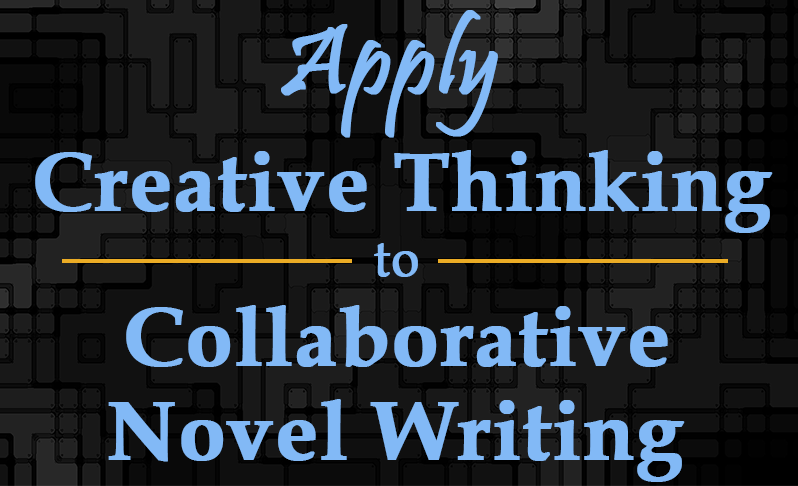Forty-five years ago Naked Came the Stranger suddenly appeared on the bestseller list, but what it took folks a long time to figure out was that the book was a hoax. Penelope Ashe, the purported author, turned out to be a host of writers for the Long Island paper Newsday, and their intent was to prove H.L. Mencken’s pronouncement that “Nobody ever went broke underestimating the taste of the American public.”
A Collaborative Novel Writing Exercise
Now you might not be interested in satirizing our country’s literary taste or lack thereof, but you could replicate the fun the staff had—especially if you like dabbling in creative writing. And even if you don’t, you might want to pick up a copy of our (written with Charlie Sweet) guidebook to writing fiction, Options (New Forums, 2014), and try your hand at the process. Along the way you’ll experience collaboration, piggybacking, glimmer-catching, and a host of other creative strategies we discuss.
What We’re Writing
Since the early part of this year with its ice and sub-zero temperatures was our winter of discontent, a group of five of us decided to try something new. All local writers, we were having lunch at the local Panera when someone suggested that a cure for cabin fever might be writing a group novel. Charlie Sweet and I had been publishing co-written fiction for over forty years, a husband-and-wife team had been writing children’s books together, and another retired professor had been updating old novel manuscripts and selling them on Amazon.com. The five of us had never written together, but Charlie and I had taught two of them in our creative writing class years ago. A “collabo-novel” seemed to be the perfect cure for the winter-time blues.
The Process to Applied Creative Thinking
Henry James claimed in “The Art of Fiction” that all writers should be given their donnee, but when we began, we had no idea what the donnee should be (actually as Jock Ewing told J.R., nobody gives you anything in this world), so we started brainstorming.
Our group had a definite advantage since we came from differing professional backgrounds. Charlie and I (both college athletes) had spent our careers as English profs while our lone female collaborwriter was a journalist; her husband, a composition instructor with a background in acting; and our “fifth wheel,” a former lawyer who taught in our university’s College of Justice and Safety. As a result, we had both a wide range of expertise and interest.
We should note here that the best productive collaborations we’ve encountered over the years have had similar diversity of background and interest—opposites don’t always attract, but they often produce the best fiction! (Tweet this quote.)
As our merry band started throwing around ideas, we were careful to exercise the cardinal rule of brainstorming: let all ideas live at first. And it’s a good thing we did! A natural tendency might have been to stitch together a modern-day crime or romance narrative with “the usual suspects and a relatively plausible plot.” Because we were open to all ideas, however, things got interesting real fast. (Tweet this quote.)
Living amid the foothills of Appalachia, we had for years been subjected to folk stories of strange creatures and weird happenings in our neck of the woods. In fact, only a couple of months before our fateful lunch, no lesser scientific authority than Animal Planet’s Matt Moneymaker and the dauntless crew of Finding Bigfoot (FB) had visited our community after hearing reports of a Sasquatch sighting.
Ah, ha, said our rhetorician—who had also appeared as an audience member on the Finding Bigfoot broadcast—what if we crafted a story involving a band of bigfoots that had taken up residence in the woods and caves of Eastern Kentucky after migrating from the north along the old buffalo trace that had become I-75?
With that glimmer, we were off and running. Yeah, chimed in our legal eagle, and what if these Appalachsquatches (Charlie’s early contribution) felt encroached upon by the ever-present and constantly-warring drug runners who used the backwoods of our county as a secretive place to ply their profession?
As the piggybacking picked up in speed, each of us threw out possible characters and plot possibilities. Before we paid our bills that afternoon, we had come up with the rudiments of a storyline, a tentative cast of characters, and even a fictional setting, the crime-ridden Clement County.
My job after that first session was to take the basic ideas and see if I could fashion an overall plot. Nothing chiseled in stone; just something to point us in a general direction. What I tried to do was suggest some patterns since Charlie and I have long adhered to our favorite literary theorist Henry James’ belief that the key to both writing and understanding fiction is finding the pattern, the figure in the carpet. (Tweet this quote.)
For our group of fictioneers, that pattern involved family relationships—especially those of father-son (hey, our group is 4/5th male).
In the following weeks each of us took ownership of certain characters and crafted scenes/chapters involving them. As we completed a piece, we sent it to our collaborwriters for critiques. Then as we met over lunch every other week, we kicked around suggestions. During these sessions we were careful to keep the atmosphere light (any collaboration depends on an absence of defensive ego) and engage in the type of creative play we mention as one of the Nifty-Nine creative strategies in our Introduction to Applied Creative Thinking (New Forums, 2013).
Often we become so engaged in story making that we enter the creative zone going with the flow, another of those creative strategies. Time flies, and we realize the afternoon is gone … and kids need to be picked up from soccer practice.
We’re now in the final stages of the novel’s first draft. Whether we ever successfully market the piece is secondary. Not only has the process taught us a lot about creativity and fiction, it’s been a real hoot–or at least a high-pitched Squatchy roar!
Author
 Ph.D Hal Blythe writes literary criticism to mystery stories. In addition to the eleven books he’s published with New Forums, Hal has collaborated on four books on a variety of subjects, over 1000 pieces of fiction/nonfiction, and a host of television scripts and interactive mysteries performed by their repertory company. He is currently co-director of the Teaching and Learning Center for Eastern Kentucky University. Meet Hal Blythe.
Ph.D Hal Blythe writes literary criticism to mystery stories. In addition to the eleven books he’s published with New Forums, Hal has collaborated on four books on a variety of subjects, over 1000 pieces of fiction/nonfiction, and a host of television scripts and interactive mysteries performed by their repertory company. He is currently co-director of the Teaching and Learning Center for Eastern Kentucky University. Meet Hal Blythe.




